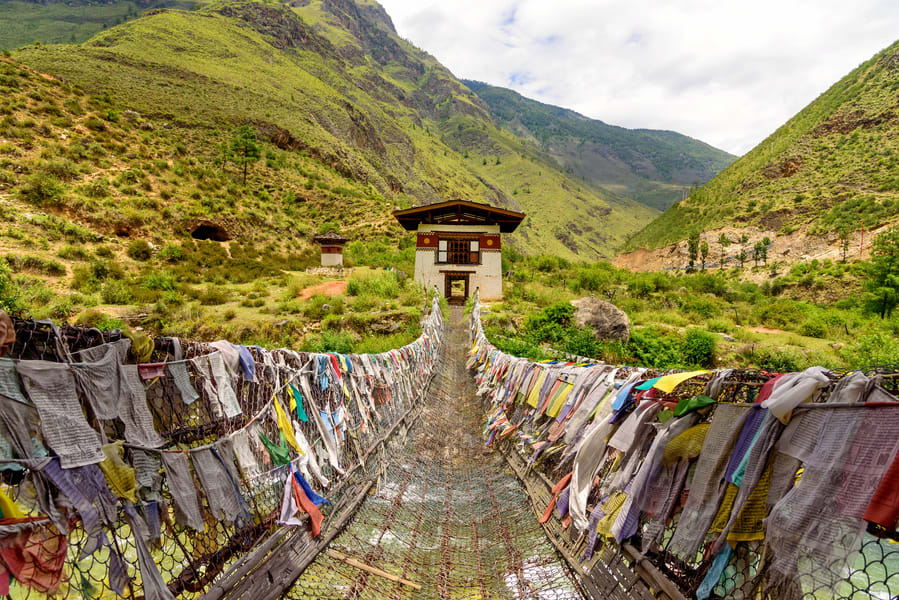
Brief History Of Tachog Lhakhang
The historic Buddhist temple Tachogang Lhakhang is located in the Paro district of Bhutan. It is thought to have been built in the thirteenth century by the Tibetan saint Thangtong Gyalpo. It can be found on the Paro Chhu river's left bank. The enormous and impressive temple is a striking example of traditional Bhutanese architecture.
The temple is well-known for its intricate carvings and decorations, which make it one of the country's most important religious sites. Additionally, it attracts domestic and international tourists to its well-known tourist attractions. The ornate carvings and sculptures that adorn the walls and ceilings of the temple, as well as the vibrant paintings and tapestries that feature Buddhist symbols and motifs, can be observed by visitors as they stroll around the grounds of the temple.
Inside the temple is the statue of Guru Rimpoche, the founder of Tibetan Buddhism. Guru Rimpoche, according to legend, visited the area in the eighth century and left his footprints there. The Buddha, Padmasambhava, and Vajrapani, among others, are depicted in a number of significant statues and paintings.
A mandala of Guru Rinpoche and a collection of sacred scriptures are among the important Buddhist relics housed in the temple. Thousands of devotees visit the temple each year to observe special rituals and pay their respects. The well-known Tachogang Festival, which takes place in December and honors Guru Rinpoche's legacy, is also held at the temple.
Tachogang Lhakhang is an important part of Bhutan's history and a significant cultural and religious site. The temple's beautiful carvings, artwork, and sculptures serve as a reminder of Bhutan's spiritual and cultural history. It is a living example of the strength and resilience of the Bhutanese people.

The Legend of Thangtong Gyalpo and the Spiritual Horse Balaha
It is said that Thangtong Gyalpo was inspired to build the temple by a vision of a spiritual horse named Balaha. He is thought to have been the first to use heavy iron chains to build suspension bridges. His work had a big impact on how suspension bridges were built in Europe and Asia.

The Architecture and Relics of Tachog Lhakhang
Upon entering Tachog Lhakhang, you will be greeted by a stunning view of the Paro Chhu and the valleys that surround it. Relics like a statue of Lord Buddha, Zhabdrung, Guru Padmasambhava, and Chenrezig Avalokiteshvara are housed in the temple's main shrine. A walking stick belonging to Lam Thangtong Gyalpo and a stack of ancient books (Kangjur and Tenjur) are also on display.
Cross the Ancient Iron Chain Bridge
You will need to cross a traditional iron chain bridge that is 900 years old to get to the temple. This will give you an exciting experience. This bridge was constructed in 1420, but in 1969, a flood washed it away. However, in 2005, it underwent restoration. With its swaying and undulating movements, crossing this ancient bridge is an exhilarating experience.

The Private Monastery and Tshechu Festival of Tachog Lhakhang
The Tshechu Festival and the Private Monastery of Tachog Lhakhang Tachog Lhakhang is a private monastery run by Thangtong Gyalpo's descendants. Visitors can request a brief visit from the monks inside the temple. Beautiful apple and orange trees surround the temple, and the locals take care of rescued cattle. Every year, the monks gather at the temple for a tshechu (festival) to read the Kanjur and Tenjur for the benefit of all living things.
Opportunities for Photography at Tachog Lhakhang
If you're into photography, Tachog Lhakhang is a great place to take some stunning pictures. The Pa Chhu river, which flows nearby, and the temple's position at the base of a mountain provide a picturesque backdrop. Along the river, you can also see rafters enjoying themselves.
In conclusion, anyone visiting Bhutan must pay a visit to Tachog Lhakhang. It is an unforgettable experience due to the history, architecture, and stunning location of the temple. Therefore, enter a world of spirituality, history, and beauty by crossing the ancient iron bridge.

Tachogang Lhakhang is an important part of Bhutan's history and a significant cultural and religious site. The temple's beautiful carvings, artwork, and sculptures serve as a reminder of Bhutan's spiritual and cultural history. It is a living example of the strength and resilience of the Bhutanese people.
Comments